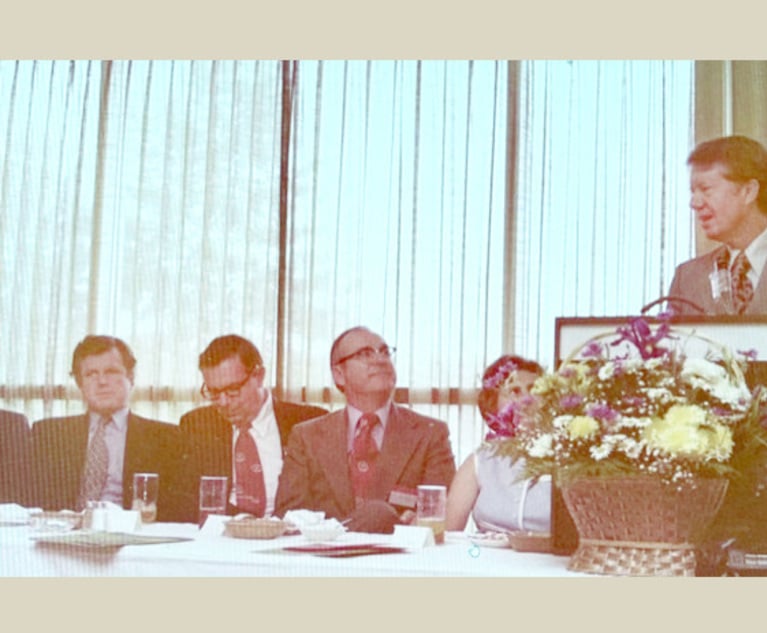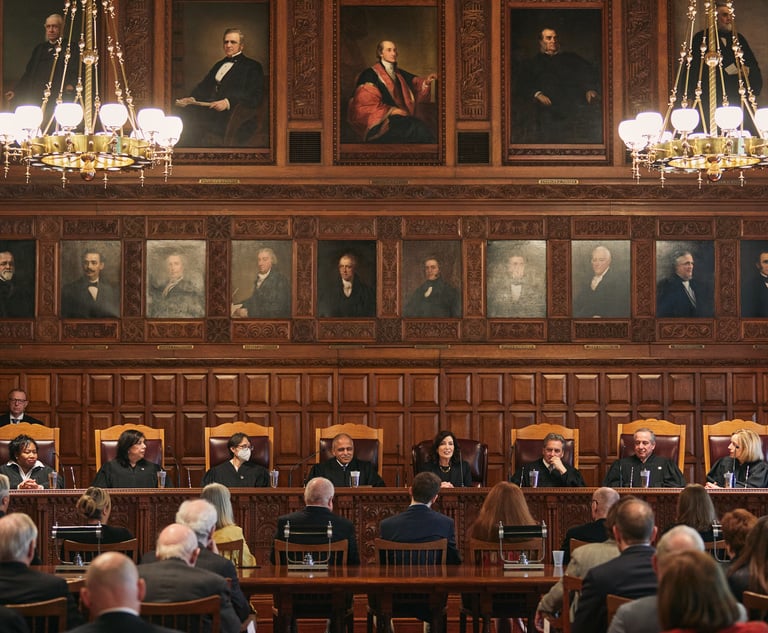The Judicial Budget for 2019-2020
New York's court system is the most expensive per capita in the country and possibly the world.
December 18, 2018 at 02:00 PM
4 minute read
 “It (New York State's Unified Court System) employs the energies of more than sixteen thousand judges, officers and employees around the State, who handle more than three million new case filings annually.” Fiscal Year 2019-2020 New York State Unified Court System Budget.
“It (New York State's Unified Court System) employs the energies of more than sixteen thousand judges, officers and employees around the State, who handle more than three million new case filings annually.” Fiscal Year 2019-2020 New York State Unified Court System Budget.
Yes, New York's Judiciary does handle more than 3 million cases per year, but they have a peculiar way of counting. For each petition filed in Family Court they give each child a separate docket number so if you have four children and file for custody it counts as four cases. They count Uniform Traffic Tickets and Parking Tickets as cases and include “both answered and unanswered cases.” For 2017 those tickets totaled 497,623 “cases” without which the total filings would be well below 3 million.
Just to put this in perspective, there were 4,671,265 filings in 2008 which is 41 percent more than 2017. The budget for 2007/2008 was a little more than $1.6 billion. The Judicial Budget for 2019/2020 is an all-time high of $2.336 billion, an increase of $44.7 million from last year. Just five years ago it was $1.81 billion even though there have been significant decreases in filings every year. When you add all costs, the judiciary spends about $600 million more but the budget never mentions the actual sum spent by the Judiciary. For example, in 2018-2019's budget the request was $2.23 billion but the Chief Administrative Judge's Annual Report four months later said that $2.96 billion was approved.
New York's court system is the most expensive per capita in the country and possibly the world. It amounts to $117 per citizen just using the State Operations Budget request of $2.336 billion, but using total funds it is over $150 per person. Florida has many more people than New York but runs its judicial budget on $27.09 per person. The United States Judiciary costs $22.25 per citizen.
As is typical, this year's Budget touts the Chief Judge's Excellence Initiative. “The success of the Excellence Initiative in eliminating delay in the performance of the court system's core functions, noted in prior budget reports and reported extensively elsewhere, has continued unabated.” To the Office of Court Administration, that has nothing to do with the 1.3 million decline in filings in the past nine years. The Budget has no explanation why it now costs $736 million more to handle 1.3 million fewer cases.
So, how does this happen? As a general rule, the legislature's oversight of the judicial budget is nonexistent. Every year they only hear from witnesses who urge the passage of the budget as a necessity for the people of the state. Among them every year is the president of the New York State Bar Association who always endorses the budget, and the leader of one of the New York charities who now receive $85 million per year from the Judiciary for Civil Legal Services. In January, the Joint Legislative Committee considering the Judiciary Budget heard from New York State Bar Association president Sharon Stern Gerstman, Chief Administrative Judge Lawrence Marks and Justine Luongo of the Legal Aid Society who received $9,786,789 from the Office of Court Administration for Civil Legal Services for fiscal year 2018-2019. All successfully urged passage of the budget by the Legislature without change. No one is ever invited who speaks against the budget. This year's budget request was signed by five people: the Chief Judge, the Chief Administrative Judge, OCA Chief of Operations, OCA Administrator of Management Support and the OCA Budget Director. In 2017 they were paid $959,065 or over $191,00o per person plus benefits. That is about three times the average median household income in the state. Maybe it is time to question why the New York court system costs so much more than any other.
Michael Friedman is the past president of the Albany County Bar Association. He practiced family law in Albany County from 1977 to 2015.
This content has been archived. It is available through our partners, LexisNexis® and Bloomberg Law.
To view this content, please continue to their sites.
Not a Lexis Subscriber?
Subscribe Now
Not a Bloomberg Law Subscriber?
Subscribe Now
NOT FOR REPRINT
© 2025 ALM Global, LLC, All Rights Reserved. Request academic re-use from www.copyright.com. All other uses, submit a request to [email protected]. For more information visit Asset & Logo Licensing.
You Might Like
View All
Jimmy Carter’s 1974 Law Day Speech: A Call for Lawyers to Do the Public Good
14 minute readTrending Stories
Who Got The Work
Michael G. Bongiorno, Andrew Scott Dulberg and Elizabeth E. Driscoll from Wilmer Cutler Pickering Hale and Dorr have stepped in to represent Symbotic Inc., an A.I.-enabled technology platform that focuses on increasing supply chain efficiency, and other defendants in a pending shareholder derivative lawsuit. The case, filed Oct. 2 in Massachusetts District Court by the Brown Law Firm on behalf of Stephen Austen, accuses certain officers and directors of misleading investors in regard to Symbotic's potential for margin growth by failing to disclose that the company was not equipped to timely deploy its systems or manage expenses through project delays. The case, assigned to U.S. District Judge Nathaniel M. Gorton, is 1:24-cv-12522, Austen v. Cohen et al.
Who Got The Work
Edmund Polubinski and Marie Killmond of Davis Polk & Wardwell have entered appearances for data platform software development company MongoDB and other defendants in a pending shareholder derivative lawsuit. The action, filed Oct. 7 in New York Southern District Court by the Brown Law Firm, accuses the company's directors and/or officers of falsely expressing confidence in the company’s restructuring of its sales incentive plan and downplaying the severity of decreases in its upfront commitments. The case is 1:24-cv-07594, Roy v. Ittycheria et al.
Who Got The Work
Amy O. Bruchs and Kurt F. Ellison of Michael Best & Friedrich have entered appearances for Epic Systems Corp. in a pending employment discrimination lawsuit. The suit was filed Sept. 7 in Wisconsin Western District Court by Levine Eisberner LLC and Siri & Glimstad on behalf of a project manager who claims that he was wrongfully terminated after applying for a religious exemption to the defendant's COVID-19 vaccine mandate. The case, assigned to U.S. Magistrate Judge Anita Marie Boor, is 3:24-cv-00630, Secker, Nathan v. Epic Systems Corporation.
Who Got The Work
David X. Sullivan, Thomas J. Finn and Gregory A. Hall from McCarter & English have entered appearances for Sunrun Installation Services in a pending civil rights lawsuit. The complaint was filed Sept. 4 in Connecticut District Court by attorney Robert M. Berke on behalf of former employee George Edward Steins, who was arrested and charged with employing an unregistered home improvement salesperson. The complaint alleges that had Sunrun informed the Connecticut Department of Consumer Protection that the plaintiff's employment had ended in 2017 and that he no longer held Sunrun's home improvement contractor license, he would not have been hit with charges, which were dismissed in May 2024. The case, assigned to U.S. District Judge Jeffrey A. Meyer, is 3:24-cv-01423, Steins v. Sunrun, Inc. et al.
Who Got The Work
Greenberg Traurig shareholder Joshua L. Raskin has entered an appearance for boohoo.com UK Ltd. in a pending patent infringement lawsuit. The suit, filed Sept. 3 in Texas Eastern District Court by Rozier Hardt McDonough on behalf of Alto Dynamics, asserts five patents related to an online shopping platform. The case, assigned to U.S. District Judge Rodney Gilstrap, is 2:24-cv-00719, Alto Dynamics, LLC v. boohoo.com UK Limited.
Featured Firms
Law Offices of Gary Martin Hays & Associates, P.C.
(470) 294-1674
Law Offices of Mark E. Salomone
(857) 444-6468
Smith & Hassler
(713) 739-1250









